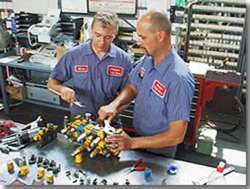


Applications

- Mobile: Here fluid power is used to transport, excavate and lift materials as well as control or power mobile equipment. End use industries include construction, agriculture, marine and the military. Applications include backhoes, graders, tractors, truck brakes and suspensions, spreaders and highway maintenance vehicles.
- Industrial: Here fluid power is used to provide power transmission and motion control for the machines of industry. End use industries range from plastics working to paper production. Applications include metalworking equipment, controllers, automated manipulators, material handling and assembly equipment.
- Aerospace: Fluid power is used for both commercial and military aircraft, spacecraft and related support equipment. Applications include landing gear, brakes, flight controls, motor controls and cargo loading equipment.
Fluid Power Products
Fluid power products are sold as individual components or as systems for the original equipment manufacturing, maintenance, repair and replacement markets. A typical fluid power system includes the following components:
- Hydraulic pump or air compressor, which converts mechanical power to fluid power.
- Cylinder or motor, which converts fluid power to linear or rotary mechanical power.
- Valves, which control the direction, pressure and rate of flow.
- Filters, regulators and lubricators, which condition the fluid.
- Manifolds, hose, tube, fittings, couplings, etc., which conduct the fluid between components.
- Sealing devices, which help contain the fluid.
- Accumulators and reservoirs, which store the fluid.
- Instruments such as pressure switches, gauges, flow meters, sensors and transducers, which are used to help monitor the performance of a fluid power system.